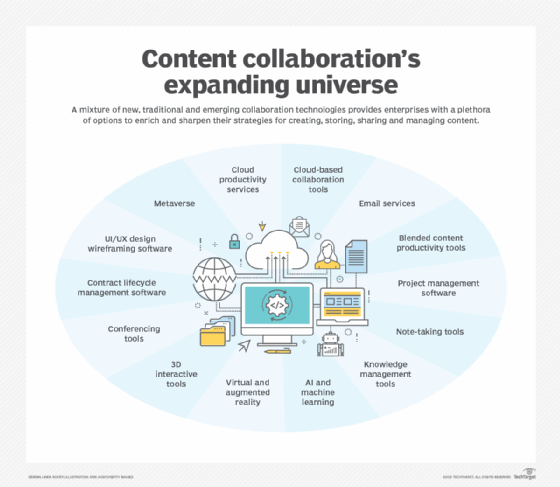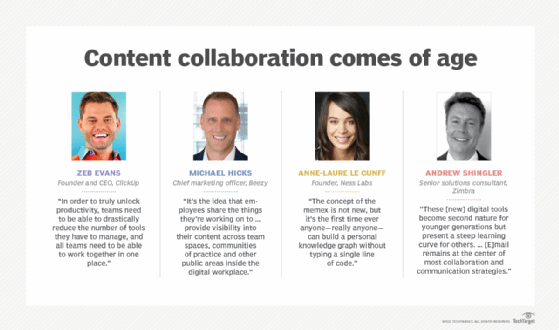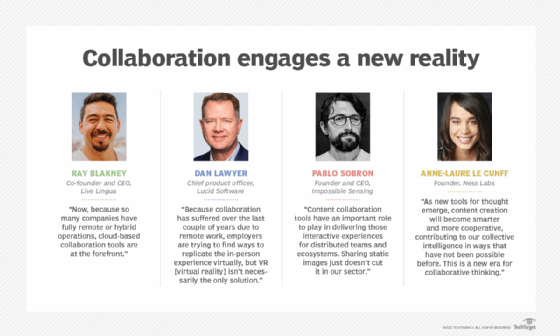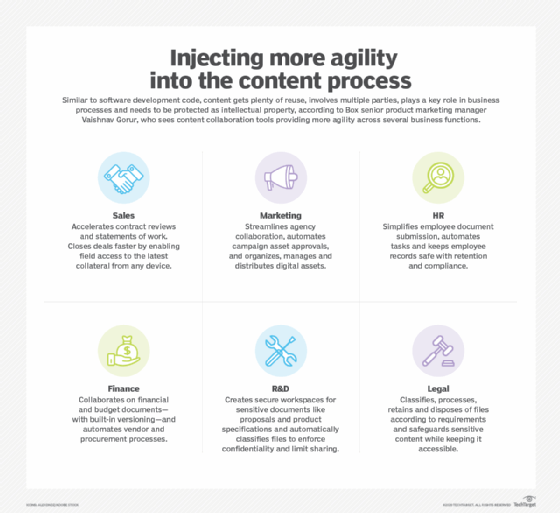Content and collaboration advance from memex to metaverse
Since World War II, content collaboration techniques have evolved from rudimentary visions of information sharing to today's knowledge management tools for the hybrid workforce.
Core ideas for weaving together new types of content workflows predate the personal computer. Yet businesses today have struggled to improve their processes for creating and sharing documents, spreadsheets and presentations.
In the wake of the COVID-19 pandemic, the limitations of existing content and collaboration workflows became apparent as employers and employees tried to adapt old office processes to the new reality of remote work. The number of workers using collaboration tools jumped from 55% in 2019 to 79% in 2021, according to a Gartner Digital Worker Experience Survey released in August.
A new generation of collaborative content tools is reinvigorating the original vision of collaborative knowledge development.
Everyone collectively wants the combination of Zoom, Word, email and file sharing to be a little less dreadful and perhaps even fun and engaging. Meanwhile, traditional content development workflows are being influenced by new collaboration approaches, more immersive content and more composable content. Unified communication software features are transitioning into workstream collaboration tools that blend chat and content development workflows. And enterprises are recognizing that metaverse content can enhance business communications.
How it all began
Some of the early concepts of computer-based content collaboration date back to before the advent of PCs and just after the first usable mainframe. In 1945, Vannevar Bush penned an article for The Atlantic that introduced a new vision of how computers -- which he coined "memex" to mean an "enlarged supplement" to our memory -- could unlock collaborative knowledge development.
In 1968, engineer and inventor Douglas Engelbart breathed life into Bush's vision with his famous "Mother of All Demos" that showed how the personal computer could change the face of communication and collaboration. But despite that promising glimpse into the future back then, content collaboration has typically coalesced into trading emails of documents formatted to fit on printed pages.
Word and PDF documents have become the content of choice for most information that businesses generate, including user regulatory filings, marketing materials, product manuals, loan applications, white papers and worker documentation. Even e-books, with their promise of new methods to organize content, are just simply a better approach to reformatting content for smaller screens.

A new way of thinking
As a result of the pandemic and acceptability of hybrid workforces, new content and collaboration tools and best practices have emerged.
Blended content productivity tools such as Zoho and ClickUp, which combine documents, chats, goals, tasks and whiteboards, are starting to take hold. ClickUp founder and CEO Zeb Evans reported that his company's user base quadrupled from 200,000 to 800,000 teams in just the last year. "In order to truly unlock productivity," Evans said, "teams need to be able to drastically reduce the number of tools they have to manage, and all teams need to be able to work together in one place."
Enterprises are likely to see some of the best results from collaboration features built into modern cloud productivity services like Google Docs and Microsoft Office. Both platforms have improved security and workflows for collaboration among larger teams.
"Now, because so many companies have fully remote or hybrid operations, cloud-based collaboration tools are at the forefront," observed Ray Blakney, CEO and co-founder of online language learning school Live Lingua. Before the pandemic, his team would walk from office cubicle to cubicle to exchange content ideas with colleagues. Now, they rely extensively on advancements in Google Drive, Google Sheets, Google Documents and Dropbox. Blakney expects multifunctional features in these types of tools will make content collaboration easier and more efficient for remote teams.

The end of email? Not so fast
Despite the promise of new collaboration paradigms, organizations will continue using email as a form of communication to accommodate older, more experienced employees. "These [new] digital tools become second nature for younger generations but present a steep learning curve for others," explained Andrew Shingler, senior solutions consultant at work collaboration service Zimbra.
Email is the one digital tool that can adequately bridge communications gaps, regardless of its perceived limitations, versus purpose-built collaboration tools. "In our planning with customers," Shingler added, "email remains at the center of most collaboration and communication strategies."
Cloud-based tools are facilitating a new collaboration concept called working out loud. "It's the idea that employees share the things they're working on to keep people in the know and provide visibility into their content across team spaces, communities of practice and other public areas inside the digital workplace," explained Michael Hicks, chief marketing officer at digital workplace platform provider Beezy.
That approach represents a departure from the notion that content collaboration is only for small groups. Working out loud can provide insight into what various teams and departments are working on across the entire organization. It also helps employees discover and reuse information that may be relevant to their projects, as well as contributing to employee engagement and workplace culture.

Enter 3D interactive collaboration
Before the pandemic, robotic and deep-sea optical sensor maker Impossible Sensing would typically bring along 3D printed scale models of its products to demonstrate and pass around to prospective customers to stimulate ideas and conversation. Its audience consisted of NASA scientists, climate researchers and prospective investors. COVID-19 lockdowns forced the company to replicate its in-person demonstrations remotely and interactively.
"We have to get people excited, which is where content collaboration tools help," surmised Pablo Sobron, founder and CEO of Impossible Sensing. The company is using Canvas GFX's Envision 3D interactive content and collaboration platform to help optimize content creation and streamline 3D collaboration processes among its product engineers, sales team and customers to generate engaging views of the product.
"Content collaboration tools," Sobron explained, "have an important role to play in delivering those interactive experiences for distributed teams and ecosystems. Sharing static images just doesn't cut it in our sector." Sobron also said his company can now hold 10 times more collaborative meetings interactively versus in person.
Nvidia's Omniverse platform for 3D design collaboration and simulation and Facebook's name change to Meta are further examples of the trending metaverse. Aside from creating more engaging games and social interactions, the metaverse could also make it easier to understand complex consumer devices like cars, whose user manuals haven't changed significantly in decades. Interactive and collaborative content is also finding its way in sales and promotional materials, instructive content and installation manuals for business and consumer end users, according to Canvas GFX CEO Patricia Hume.
Collaborative software vendors are exploring new ways to create more immersive meeting experiences, while businesses try to establish where these tools add the most value. "Because collaboration has suffered over the last couple of years due to remote work, employers are trying to find ways to replicate the in-person experience virtually," said Dan Lawyer, chief product officer at visual collaboration platform provider Lucid Software. "But VR [virtual reality] isn't necessarily the only solution, especially at this point."

Back to its origins
Ironically, new types of content and collaboration tools carry Bush's original vision of the memex. Notion's note-taking and project management software, for example, can create and share dynamic content in smaller, more composable chunks. Platforms like Roam Research, Amplenote and Mem can create associative links between chunks of shared knowledge for collaborative learning, scholarly research and product development. New enterprise-grade offerings such as Zenkit's Hypernotes build on these core capabilities with support for single sign-on, access management and audits.
"The concept of the memex is not new, but it's the first time ever anyone -- really anyone -- can build a personal knowledge graph without typing a single line of code," observed Anne-Laure Le Cunff, founder of knowledge collaboration advisory Ness Labs. "As new tools for thought emerge, content creation will become smarter and more cooperative, contributing to our collective intelligence in ways that have not been possible before."
The metaverse field has been galvanized by the example of sociologist Niklas Luhmann's Zettelkasten knowledge management method, which allowed him to produce more than 75 books and 500 articles. Although software can help curate this knowledge, it's still a manual process -- but improvements in artificial intelligence technologies might help. IBM's Project Debater, for example, demonstrated how AI could help extract and organize complex topics in a larger-scale discussion. "This is a new era for collaborative thinking," Le Cunff declared.
More organizations will automate the distillation of insight from raw data, conjectured Sam Babic, senior vice president and CTO at content services provider Hyland Software. Enterprises are in the early stages of finding ways to combine data warehousing, data aggregation and machine learning to graduate data to information, knowledge, insights and wisdom, which could help scale Bush's original collaboration ideas for the masses.






